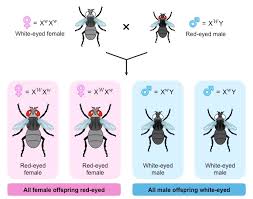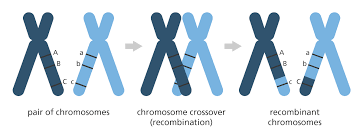LINKAGE AND CROSSING OVER-AN OVERVIEW
Genetic linkage is the tendency of genes to remain together on a chromosome and/or to be inherited together when the gametes are formed during the meiosis phase of sexual reproduction.

Points related to Genetic Linkage
- Bateson & Punnet (1906) found that two pair of alleles did not assort independently while working on ground pea. The same findings were observed by T.H Morgan in 1910 while working with Drosophila.
- Here both the genes, located on same chromosome inherited together. Such genes are called linked genes and group of such linked genes is called linkage group.
Read also….DIFFERENCE BETWEEN GENE AND ALLELE
3. Such genes have tendency to remain together during the process of inheritance.
4. The strength of linkage depends on the distance between the linked genes. Crossing over, when takes place such linked genes get separated.
5. A line on which the genes are represented by points separated by distances proportional to the amount of crossing over is called linkage map or genetic map or chromosome map.
Crossing over is the exchange of chromosome segments or genetic material between non-sister chromatids of homologous chromosome. It is also known as chromosomal cross over. Crossing over is essential for the normal segregation of chromosomes during meiosis.

Points related to Crossing Over
- The physical basis of crossing over was first demonstrated by Harriet Creighton and Barbara McClintock in 1931.
- Crossing over occurs during Pachytene stage of prophase 1 of meiosis cell division.
- It occurs when synapsis takes place (synapses means pairing of homologous chromosome).
- It results in recombinant chromosomes during sexual reproduction that is the final phases of genetic recombination. Recombination results in a new arrangement of maternal and paternal alleles on the same chromosome.
- The crossing over varies from 0-50% and will never cross 50% and the non-cross over vary from 50-100%.
Read more…
CROSSING OVER- PROCESS & FUNCTION
MENDEL’S LAW OF INHERITANCE
SYNAPSIS MEANING- PROCESS & FUNCTION
HOMOLOGOUS CHROMOSOMES-AN OVERVIEW & FUNCTION
DIFFERENCE BETWEEN GENE AND ALLELE
MITOSIS & MEIOSIS- CELL DIVISION